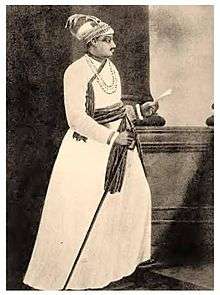Shia Islam in Bangladesh
Shia Muslims are a large minority in Bangladesh, with roughly 2% of the population being Shia.[1] Many Bangladeshi Shi'a Muslims, belong to the Bihari community. The Shi'a observance commemorating the martyrdom of Ali's sons, Hasan and Husayn, are still widely observed by the nation's Sunnis, even though there are small numbers of Shi'as.[2] Among the Shias, the Dawoodi Bohra community is concentrated in Chittagong as well as the Nizari Ismaili community also found in Dhaka.[3] The Hussaini Dalan is the biggest Shia masjid and the main Hussainiya of the country.
_being_a_synopsis_of_the_history_of_Murshidabad_for_the_last_two_centuries%2C_to_which_are_appended_notes_of_places_and_objects_of_interest_at_Murshidabad_(1905)_(14776529292).jpg)
| Total population | |
|---|---|
| approx. 2,972,000 (2011 estimate) | |
| Religions | |
| Shia Islam, mainly Twelver and Dawoodi Bohra & Nizari | |
| Languages | |
| Bengali and Urdu (by the Bihari Muslim community) |
| Part of a series on Islam Shia Islam |
|---|
 |
|
Beliefs and practices |
|
|
Holy women |
|
|
History

Most of the Twelver Shias migrated to South Asia to prosper and obtain high positions in various Sultanates and later Mughal Empire. Many were also rebels and nobles who lost royal favour in Persia and migrated to Mughal Empire. The Mughals also preferred to employ foreign Muslim officials that had no local interests and thus were loyal to the Mughal emperor. All the Nawabs of Bengal happened to be Shia Muslims.
Sultanate era
During the reign of the Sultan of Bengal, Alauddin Husain Shah, many paiks and other administrative position holders were of Habshi origin. After many significant agitations, as well as after the disestablishment of the Habshi dynasty, Husain Shah replaced the Habshis with Arabs, Turks, Persians (Shias) and local Bengalis. A Shia nobleman from Persia known as Sakhi Salamat of Isfahan settled in the village of Prithimpassa, Kulaura in 1499. His son, Ismail Khan Lodhi was later on given the status of Nawab.
Mughal era
From 1717 until 1880, all three successive Nawab dynasties – the Nasiri, Afshar and Najafi – ruled what was then known as Bengal.[4]
The first dynasty, the Nasiri, ruled from 1717 until 1740. The founder of the Nasiri, Murshid Quli Khan, was born a poor Deccani Odia Brahmin before being sold into slavery and bought by Haji Shafi Isfahani, a Persian merchant from Isfahan who converted him to Shia Islam. He entered the service of Mughal Emperor Aurangzeb and rose through the ranks before becoming the Nawab Nizam of Bengal in 1717, a post he held until his death in 1727. He in turn was succeeded by his son-in-law, Shuja-ud-Din Muhammad Khan.[5] After Shuja-ud-Din's death in 1739 he was succeeded by his son, Sarfaraz Khan, who held the rank, until he was killed in the Battle of Giria in 1741, and was succeeded by Alivardi Khan, former ruler of Patna, of the Afshar Dynasty in 1740.[6]
The second dynasty, the Afshar, ruled from 1740 to 1757 starting with Alivardi Khan. Siraj ud-Daulah, the last Afshar Nawab was killed in the Battle of Plassey in 1757 by the British Empire[7] They were succeeded by the third and final dynasty to rule the whole Bengal, the Najafi.[8] The first Najafi Nawab was Mir Jafar in June 1757 and the post was abolished in November 1880 with Mansur Ali Khan as the final Nawab of Bengal.
In 1799, Agha Muhammad Reza, a Mughal Shia nobleman in Sylhet of Iranian origin rebelled against the East India Company. Gaining support from thousands of peasants after claiming to be a Sufi saint, Reza successfully invaded the nearby Kachari Kingdom. Later proclaiming himself as the Mahdi (promised messiah) and twelfth imam, he was captured and imprisoned in Calcutta.[9][10]
Pakistan era
Political influence
Muhammad Ali Jinnah, the Quaid-e-Azam ("the Great Leader"), the founder of the state of Pakistan, was born into an Ismaili Shia family although later in life he followed Twelver Shia Islam.[11]
Modern era
There is a very small minority of Sylheti Shias who gather every year during Ashura for the Mourning of Muharram processions in places such as Prithimpasha Nawab Bari in Kulaura, home to a Shia family, as well as Balaganj, Osmani Nagar and Rajtila.
See also
- List of Shia Muslim Dynasties
- Public holidays in Bangladesh
- Shia Islam in India
- Shia Islam in Pakistan
References
- "Chapter 1: Religious Affiliation". The World's Muslims: Unity and Diversity. Pew Research Center's Religion & Public Life Project. 9 August 2012. Retrieved 4 September 2013.
- "Islam in Bangladesh". OurBangla. Archived from the original on 2007-02-19. Retrieved 2008-02-14.
- Ferdousi, Ishrat (20 October 2007). "Yasmin Farzana Shafi". The Daily Star. Retrieved 14 February 2017.
- Rahman, Urmi (23 December 2014). Bangladesh - Culture Smart!: The Essential Guide to Customs & Culture. Bravo Limited. ISBN 9781857336962.
- "Biography of Murshid Quli Khan". Murshidabad.net. 20 May 2012. Retrieved 9 August 2012.
- "Defeat of Sarfaraz Khan in the Battle of Giria". Murshidabad.net. 8 May 2012. Retrieved 9 Aug 2012.
- "Defeat of Siraj ud-Daulah in the Battle of Plassey". Retrieved 28 July 2012.
- "Dynasties of The Nawabs". Murshidabad.net. 8 May 2012. Retrieved 9 August 2012.
- Banerjee, Anil Chandra (1946). "Troubles in Assam (1795-1824)". The Eastern Frontier Of British India, 1784-1826. Assam: A. Mukherjee. pp. 199–200.
- Sirajul Islam; Aklam Hussain, eds. (1997). History of Bangladesh, 1704-1971. 2. Asiatic Society of Bangladesh. p. 185.
- Ahmed, Khaled (24 December 2010). "Was Jinnah a Shia or a Sunni?". The Friday Times.